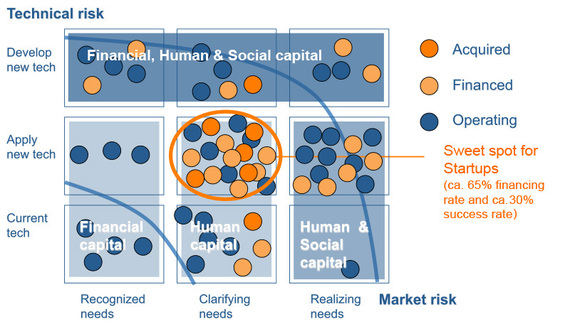Successful startup founders are fueled by passion, a willingness to take risk and do whatever is necessary to make things happen. What they initially lack in financial capital, they more than make up for in human and social capital. So, how do startup teams most effectively match their limited resources and time to a cutthroat market and technology environment? How do they obtain funding and move down the road to becoming profitable?
In collaboration with Stanford's Studio for Venture Design, Art Center College of Design - The Design Accelerator and Innovate Pasadena, we researched over sixty startups in Silicon Valley and San Gabriel Valley, uncovering a "sweet spot" for these nascent businesses. Positioning the startups in a Market - Technology risk matrix revealed that a somewhat conservative approach to combining market and technology risk leads to the best results.
Startups that opted to focus on "clarifying a user need," which is associated with medium risk, as opposed to "discovering or realizing completely new needs," as associated with high risk, faired fifteen percentage points percent better on average. Even more impressive, startups that applied new proven technologies, associated with medium risk, to these clarified needs, were, by thirty percentage points, most likely to be not only funded but also to be acquired by larger competitors.
This intuitively makes sense since the top area of "Developing New Technology" is financial, human and social capital intensive and the large established players have had years to accrue these specific areas of capital.
When addressing the left area, "Recognized Need," one is competing with equally large, incumbent players. These are intimately familiar with the market and have the financial resources, together with the brand value, to launch mega advertising campaigns.
The right area, "Realizing Needs," requires a wide network for spotting new paradigm shifts, something startups, with only a few geeks in their organization, are unable to match.
Finally, Applying "Current Technology" and "Clarifying Needs" is the first hunting ground incumbents explore when a quick increase in the numbers are demanded. Therefore, this area has most likely been mined to death, offering few unidentified opportunities.
The only remaining area that offers the best match for the typical profile of a design startup founder is "Clarifying Need" and "Applying New Technology." This area continues to offer lucrative positioning in established firms as well but it may be more difficult for established firms to get internal backing for entering this area.
So, if the founders are relative inexperienced, they may be wise to gain technical and customer proficiency experience in their field. Most especially, experience in how best to organize and run design team projects, prior to venturing out on their own. In other words, acquire the financial, human and social capital for embarking on a three to five year learning experience with an eighty to ninety percent failure rate.
Clearly identifying and staying closely connected to real users, providing them with new concrete advantages though proven solutions, seems to be a winning strategy for fast moving lean startups on a shoestring budget. Venturing outside this narrow Market - Technology risk niche increases risk disproportionally and may, therefore, be better suited for well-financed larger players. By carefully aligning human and social capabilities with market needs, one can increase opportunities for hitting a startup's sweet spot.
